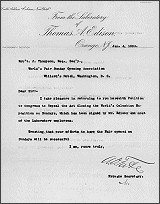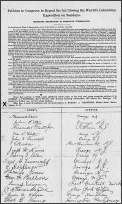
Petition Signed by Thomas A. Edison for Sunday Openings at the World's Columbian Exposition
Background
In 1893, in just 184 days, 28 million people, about one-third of the American population, visited the World's Columbian Exposition in Chicago. Beyond the exhibits, visitors witnessed a panoply of constitutional rights. In particular, they saw the First Amendment in action. Citizens petitioned the fair's managers. Citizens assembled peaceably. Citizens exercised freedom of speech and religion. The subjects of the petitions, assemblies, and speeches foreshadowed 20th century debates over social issues, including religion, gender, and race. Chicago itself testified to rapid urban growth and a Phoenix-like ability to rebuild after the devastation of the Great Fire. Now the population totaled about 1,550,000, with one-third foreign born. The city was celebrating 400 years of "progress" since Christopher Columbus's discovery of America and anticipating a new century of greater progress. Progress meant new products, such as Cracker Jacks, Pabst Beer, and Juicy Fruit gum. Progress meant new landscape Architecture, exemplified at the fair with lagoons and paths designed by Frederick Law Olmstead. Progress meant new technology, featured in exhibits of George Westinghouse's alternating-current generators and Thomas Edison's moving-picture kinetograph. Progress meant sculptures on a grand scale, such as Daniel Chester French's "The Republic" that stood as a monument to democratic ideology. The fair's 65,000 exhibits certainly celebrated the progressive, happier side of the 1890s. However, amid the testimonials to American progress, the strains and stresses of an urbanizing and industrializing society bubbled to the surface.
Within the walls of the beaux-arts-style Architectural structures, the World Congress Auxiliary, one of the groups that helped organize the fair, offered a vast program of public events. Almost 700,000 visitors attended 1,245 sessions. Speakers, protected by the First Amendment, lectured on women's progress, medicine, temperance, social reform, education, engineering, government, philosophy, Sunday rest, agriculture, and real estate. The issues certainly divided the audience. So did the schedule for the sessions. In facing the question of scheduling the events at the fair, the managers touched off a volatile debate. Should the fair open on Sundays? The Fair managers waffled. Among other things, their debate revealed growing social and economic tensions between classes. Established social mores echoed Puritan blue laws: no businesses opened on Sundays. At one point, opponents of Sunday openings persuaded Congress to pass a resolution prohibiting funding for Sunday openings. In response, supporters of Sunday openings resorted to an exercise of First Amendment rights. They petitioned Congress. And they recognized the advantage of having a "big name" as a signatory. The name Thomas Edison dominated the list of signatures attached to a "Petition to Congress to Repeal the Act Closing the World's Columbian Exposition on Sundays." Most of Edison's Orange, New Jersey, laboratory employees penned their names on the petition as well. Sunday openings, they argued in a petition subtitled "Religious Toleration is Christian Civilization," would open a world of education, art, and appreciation. Thus their petition, an action protected by the First Amendment, cited another right within the First: the freedom of religion. The petition summarized a larger debate: How would the country deal with workers who depended on industry for 6-day-a-week jobs, not on personal relationships with employers? The working class, central to industrialization, could visit the fair only on Sundays. Fair managers first closed, then opened, then closed on Sundays. As novelist Henry James remarked, "the dreadful chill of change" filled the air.
Speakers at the Women's Building found themselves at the center of other controversy. Authorizing and building the "Women's" Building had marked another "dreadful chill" for some who feared it as a recognition of new roles for women. To manage the fair, Congress had created an all-male commission. In turn, Congress, after hearing from determined American women, permitted the commission to appoint a Board of Lady Managers. The board's chair, Bertha Honore Palmer (Mrs. Potter Palmer), found the Lady Managers both praised and condemned. Supporters praised them for envisioning a Woman's Building, filled with works created by women; opponents criticized them for separating women's works from men's. Ultimately they built the Woman's Building, following Architect Sophia Hayden's plan, and filled it with exhibits from American, European, and Latin American women. Japanese women, the Japanese ambassador to the United States wrote, were not "sufficiently advanced" to serve in planning a Japanese exhibit. Bertha Palmer recognized the use of federal dollars in her dedicatory speech: "Even more important that the discovery of Columbus is the fact that the general [federal] government has just discovered women." The conflicts between the Lady Managers and the all-male commissioners reflected the late 19th-century debates over women's roles and contributed to the growth of the suffrage movement and, in 1919, to the ratification of the 19th Amendment to the Constitution.
The Board of Lady Managers included no black Americans. At first the fair planned no role for black Americans. In protest, Mrs. Ida B. Wells distributed her pamphlet, "The Reason Why the Colored American is not Represented in the World's Columbian Exhibition." Ida Wells, a native of Holly Springs, Mississippi, who led an anti-lynching crusade in the South before moving to New York, asked: "Those visitors to the World's Colombian Exposition . . . especially foreigners will naturally ask . . . Why are not the colored people who constitute so large an element of the American population, and who have contributed so large a share to American greatness, more visibly present and better represented in this World's Exposition? Why are they not taking part in this glorious celebration of the four-hundredth anniversary of the discovery of their country? Are they so dull and stupid as to feel no interest in this great event? " Minus the vote, Wells made great use of her First Amendment rights. With Frederick Douglass as the co-author of her pamphlet, Wells addressed the controversy of African American representation at the fair. They won a role. Separate from the Lady Managers, black women formed the Women's Columbian Auxiliary Association, following a pattern of creating "auxiliary" associations common in the United States. Black women lecturers at the World's Congress of Representative Women--Hallie Q. Brown of Tuskegee, Sarah J. Early of Tennessee, and Frannie Barrie Williams--offered differing views of black women as citizens. Should they dedicate themselves to manual labor? Should they solicit social equality? Should they strive for political equality? Frederick Douglass, present every day to represent the Haitian government, concluded: "I have heard tonight what I hardly expected ever to live to hear. I have heard refined, educated, colored ladies addressing--and addressing successfully--one of the most intelligent white audiences that I ever looked upon." The First Amendment protected them; the 19th was still a dream.
As Chauncey Depew suggested in an interview with the New York Times on June 19,1893, the fair was "the world in miniature." As such, amid all the hoopla and the new products, class, racial, and gender conflicts permeated the fair just as they were permeating American society at large. The exercise of the First Amendment protected the debaters, regardless of the popularity or unpopularity of their positions.
Resources
Badger, R. Reid. The Great American Fair: The World's Columbian Exposition and American Culture. Chicago: Nelson Hall, 1979.
Schulman, Bruce R. "Interactive Guide to the World's Columbian Exposition."
http://users.vnet.net/schulman/Columbian/columbian.html
Sklar, Kathryn Kish and Thomas Dubin. "Women and Social Movements in the United States, 1830-1930"
http://www.binghamton.edu/womhist/index.html
Wells, Ida Bell, and Frederick Douglas. "The Reason Why the Colored American is not Represented in the World's Columbian Exposition." http://womhist.binghamton.edu/ibw/doclist.htm.
The Documents
Cover Letter

Click to Enlarge
National Archives and Records Administration
Records of the U.S. Senate
Record Group 46
National Archives Identifier: 306408
Image #1
Petition

Click to Enlarge
National Archives and Records Administration
Records of the U.S. Senate
Record Group 46
National Archives Identifier: 306408
Image #2
Article Citation
This article was written by Linda Simmons, an associate professor at Northern Virginia Community College, in Manassas, VA.